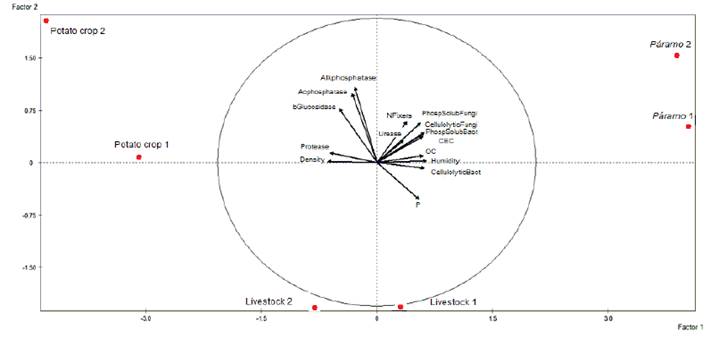Introduction
Páramos constitute one of the most important and unique ecosystems in the world, but also one of the least known (Hofstede, 2001). They are of great importance for providing drinking water to a large proportion of the population, store and intercept water, harbour endemic flora and fauna, and provide environmental services such as atmospheric carbon mitigation spaces (Vargas et al., 2012). The Páramos top the list of biodiversity hotspots around the world (Myers et al., 2000); as approximately 6.7% of the endemic plants in the world and 5.7% of global vertebrate species are observed throughout the mountainous gradient (Llambí et al., 2012). This is a key point since biodiversity hotspots have lost about 86% of their original habitat and are considered to be significantly threatened by extinctions that may be generated by global warming (Carrillo et al., 2019).
The greatest impact in the Northern Andean Páramos comes from livestock, agriculture, and vegetation burning that is associated with these activities (Hofstede, 2001). Today, at least 60% of the Páramos are subject to continuous use (Hofstede, 2001), for example, 40% of the Páramos in Ecuador were turned into crops and other 30% work as moderate grazing areas (Hofstede, 2001). In Colombia, 10% of what was Páramo is use for potato crops, without counting other types of crops that vary depending on the area and ranging from smallholdings to industrialized crops. These agricultural and livestock farms have led to significant transformation and also caused serious changes in the composition, structure, and dynamics of these ecosystems, given by the destruction of native vegetation to give space to grazing areas for livestock farming and potato crops, as well as to the massive application of pesticides and fertilizers, which has generated losses of organic matter, alteration of biogeochemical cycles, and water retention (Rojas et al., 2012).
Although these studies have been developed in different contexts of agricultural cropping and in the evaluation of the changes that have taken place due to potato cropping and livestock farming, the necessity for more specific research in soils of the Páramo ecosystem becomes evident, as it is important to follow up the behaviour of the Neotropical ecosystems in the face of agricultural activities. Moreover, from this approach, recommendations for both the Páramos and similar ecosystems could be suggested.
The purpose of this research was to evaluate and analyze the impact of potato crops and livestock farming on the indicators of soil quality in the Northern Andean Páramo soils of the neotropics, as in the case of Colombia, through the following objectives: (1) to evaluate the physical-chemical properties of the soils that are exposed to potato crops and livestock farming; (2) to evaluate the abundance of functional groups of microorganisms in the soils that are exposed; and (3) to analyze the impact of potato crops and livestock farming on the enzymatic activities of the soils that are exposed.
This research hypothesized that the physicochemical properties, the abundance of functional groups of microorganisms, and the enzymatic activities of the soil in the Páramo ecosystems could be modified significantly by the activities of livestock farming and potato cropping.
Materials and methods
Description of the site of study
The study was conducted in the municipality of Choachí, Cundinamarca (Colombia) located at the coordinates 04° 35’39’’ N, 73° 60’ 08’’ W, 36.8 km in Bogotá (Figure 1).
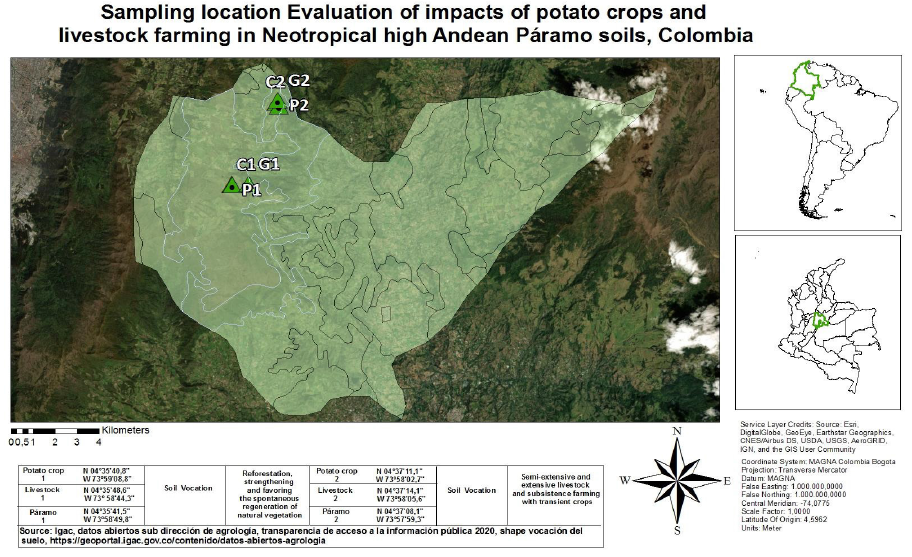
Figure 1 Geographic location of the study sites. P1: Páramo 1, P2: Páramo 2, L1: Livestock 1, L2: Livestock 2, C1: Potato Crop 1, C2: Potato Crop 2.
Most of these soils are influenced by volcanic ash, and the parental material consists of shales, shales calcareous, sandstone, and volcanic ash, which are generally black due to the interaction between the allophane and the organic matter, and tend to be acidic, with a diversity of shrub species, which have high moisture retention (Ramirez, 2012). The predominant climate is cold with a temperature between 2 °C and 10 °C: there is significant rainfall throughout the year in the municipality of Choachí. Even the driest month still reports a lot of rain; the average rainfall is 1128 mm per year. The total population is 10,729 inhabitants divided into rural (7114 inhabitants) and urban (3615 inhabitants). A large part of its economy is based on the cultivation of potatoes and onions, and on livestock farming; also, Páramos are considered the main ecosystem in the area, because they possess endemic fauna and flora, in addition to providing different environmental services to the inhabitants of the municipality.
The potato (Solanum tuberosum) varieties cropped are Parda Pastusa and R12 (Avellaneda- Torres, 2014). During harvest, the crop uses pesticides (carbofuran), insecticides (thiamethoxam or lambda cyhalothrin), herbicides (paraquat dichloride or fluazifop-p-butyl), and fungicides (chlorothalonil) (Díaz-Granados et al., 2017).
The Norman cow breed cattle is usually raised for the purpose of meat consumption requirements such as the production of milk, cheese, and meat, besides breeding, reproduction, and sale. This type of livestock is called extensive since there are large tracts of land with few animals that feed directly from what the land produces.
It is relevant to make clear that in this area, there is a combination of the traditional knowledge of peasants: resting periods in the cultivated soils should be allowed, cultivation time should be maximum two years in rotation with livestock farming, and as specified above, the proportion of the number of head of livestock on land extension should be small; with practices inherited from the Green Revolution, such as the application of the aforementioned agrochemicals.
Experimental design and soil sampling
In order to evaluate the hypothesis about the fact that the activities of potato cropping and livestock farming modify the properties of Páramo soils, soil sampling was carried out in July 2018, a month with the highest rainfall record. The gathered samples were named according to the use of the soil where they were collected, as follows:
Potato cropping soils. These crops showed rotation of place and had just been harvested at the time of the sample.
Livestock farming soils, modified by livestock farming, which were part of the potato-pasture rotation system.
Páramo soils that have not been intervened and maintain native vegetation such as frailejones (Espeletia sp.) and some shrubs like Ageratina sp and Baccharis sp.
Three samples were collected in every area with different soil use (potato cropping, livestock farming, Páramo), consisting of 10 subsamples; each sample was taken at two different heights: 3100 m.a.s.l. and 2970 m.a.s.l.. Samples were named and georeferenced (Table 1).
Table 1 Coordinates and conventions of each land use: potato crops, livestock, and Páramo according to height in meters above sea level.

Potato crop-1: Potato crop altitude1. Livestock 1: Livestock altitude1. Páramo 1: Páramo altitude1. Potato crop-2: Potato crop altitude2. Livestock 2: Livestock altitude2. Páramo 2: Páramo altitude2.
Sampling area was delimited for the sample collection, and observation of biotic conditions were recorded. The course was traced in zigzag for the collection of three samples, composed of 10 subsamples of the first 30 cm of soil for each soil use and altitude. Collected samples were deposited in plastic bags properly labelled and stored at -4 °C for microbiological analysis, -20 °C for enzymatic analysis, and room temperature for physicochemical analysis; all analyses were performed by triplicate in the laboratory.
Physicochemical analysis
Gravimetric humidity was determined by the gravimetric method; bulk density according to the cylinder method; pH in water according to the potentiometric method with soil: water (w/v) ratio of 1:1; organic carbon by the Walkley and Black method; exchangeable acidity by extraction with 1M potassium chloride (KCl); cation exchange capacity by means of extraction with 1N ammonium (NH4) acetate; available phosphorus by the Bray III method; Bouyoucos soil texture; calcium, magnesium, potassium and sodium bases by extraction with 1N ammonium (NH4) acetate (IGAC, 2006; Avellaneda et al., 2018).
Microbiological analysis
10g soil samples were suspended in 90 ml of 0.85% saline solution and vortexed for 10 minutes. Subsequently, 100pl of this suspensión was used to make serial dilutions from 10-1 to 10-9. Microorganisms abundance was assessed by isolations and counts made according to the plate counting method. Nitrogen-fixing bacteria counts and isolation was performed according to Rennie (1986) and modified by Avellaneda et al. (2014), consisting of a selective medium lacking nitrogen. Cellulolytic microorganisms were assessed according to Hendricks et al. (1995) and modified by Avellaneda et al. (2014). In this, colony forming unit are counted in medium with carboxymethylcellulose (CMC) at 1%. Phosphate solubilizer bacteria were assessed according to Pramer and Schmidt (1964); Sundara Rao and Sinha (SRS), and modified by Avellaneda et al. (2014). Bacteria culture was incubated at 25 °C for 48 hours., Fungi was incubated at room temperature for a period of five to seven days. Finally, viable cells were counted in the plates containing between 30 and 300 CFU.
Enzymatic analysis
Aiming to determine the enzymatic activity, 0.1 g of soil was collected; acid phosphatase, alkaline phosphatase, and p-glucosidase activities were assessed using 0.2 g soil samples. Enzymatic activity was determined by colorimetric methods according to Avellaneda et al. (2018). Urease method described by Alef and Nannipieri (1995) was used to determine the ammonium released from soil incubated samples with urea solution for 2 hours at 37 °C; ammonia is extracted with a Potassium Chloride solution and determined by a modified Berthelot reaction (Sodium Salicylate with Ammonia in the presence of Sodium Dichloroisocyanide). The protease method described by Ladd and Butler (1972) used to determine the resulting amino acids after soil incubation in sodium caseinate for 2 hours at 50 °C using the Ciocalteu reagent. The p-Glucosidase method described by Eivazi and Tabatabai (1988) was also used for the colorimetric determination of the p-nitro phenol obtained by the action of the p-Glucosidase after soil incubation with the p-D-glucopyranoside substrate in a buffered medium at pH 6.0. The acid and alkaline phosphatase-based method described by Alef and Nannipieri (1995) was used to determine the p-nitrophenol released after soil incubation with p-nitrophenyl phosphate solution for 1 hour at 37 °C. Released p-Nitrophenol is extracted and coloured with Sodium Hydroxide and photo-metrically determined.
Statistical analysis
The assumptions of independence, variance homogeneity and normality were assessed in order to determine the use of the parametric statistics; for the normality analysis the Shapiro- Wilk test was used, but because the data did not satisfy the assumption of normality, the Kruskal-Wallis, Wilcoxon, Kolmogorov-Smirnov, and Tukey, nonparametric tests were applied with a significant level of P < 0.05. All tests were performed with the free software R 2.10.0.
Multivariate analysis was carried out using the principal component analysis method (PCA), and the simple correspondence analysis (SCA) (soil use vs. physicochemical, microbiological, and enzymatic properties). This test was performed using the free software R 2.10.0 and the SPAD v.7 software.
Results
Physicochemical analysis
Soil water content in Páramo-1 and Páramo-2 was 79.6% and 89.7%, respectively, while potato cropping-1 (36.8%) and potato cropping-2 (33.4%) presented significantly lower humidity (Figure 2A). In this way, the trend regarding soil moisture at Páramo> Livestock> Potato crops was maintained.
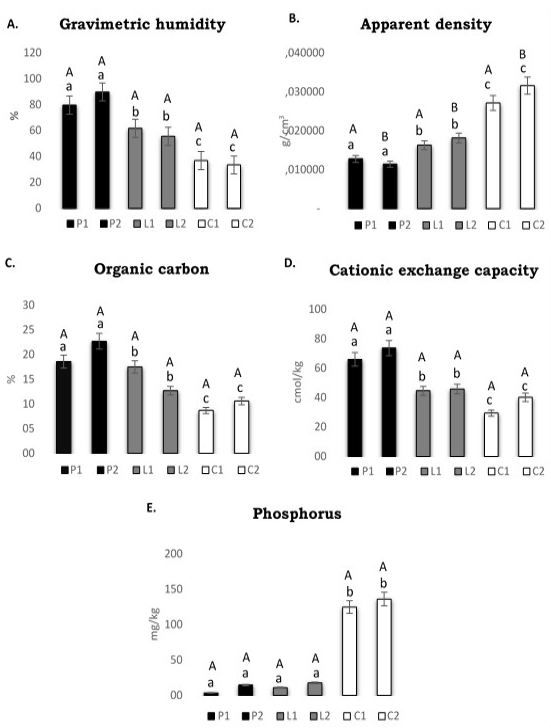
Figure 2 Physicochemical parameters in Páramo, livestock and potato crop soils. A. Gravimetric Humidity. B. Apparent Density. C. Organic Carbón. D. Catión Exchange Capacity. E. Phosphorus. P1: Páramo 1, P2: Páramo 2, L1: Livestock 1, L2: Livestock 2, C1: Potato Crop 1, C2: Potato Crop 2. Same lowercase letter does not have a significant statistical difference between uses. Same capital letter does not have a significant statistical difference between altitudes.
The most intervened soils had high apparent density at both heights (Potato cropping-1: 0.027 g/cm3, and Potato cropping-2: 0.032 g/cm3) followed by Livestock farming-1: 0.016 g/cm3 and Livestock farming-2: 0.018 g/cm3, which were also high (Figure 2B). A significant trend related to apparent density was Potato cropping> Livestock farming> Páramo.
In less intervened soils, high content of organic carbon was found (Páramo-1: 18.6%, and Páramo-2: 22.7%). These results presented significant differences with respect to the results of livestock and potato crops (Figure 2C), showing significant trend for Páramo> Livestock farming> Potato cropping in terms of the organic carbon.
Cation exchange capacity for Páramo soil was significantly higher in Páramo-1: 66 cmol/kg and Páramo-2: 73.7 cmol/kg; while lower for Potato cropping-1: 29.4 cmol/kg, and Potato cropping-2: 40.2 cmol/kg soils (Figure 2D).
Results showed phosphorus availability with significant difference with higher levels in most intervened soils (Potato cropping-1: 125 mg/kg, and Potato cropping-2: 136 mg/kg), in relation to Livestock farming and Páramo (Figure 2-E). No statistically significant differences for pH, interchangeable acidity, exchangeable aluminium saturation and total bases were observed (Table 2).
Table 2 Physicochemical analysis results of Páramo soils, livestock and potato crop.
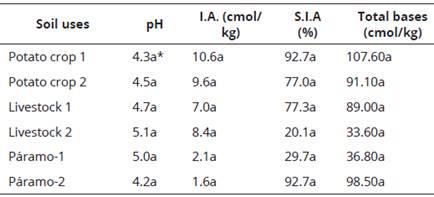
Potato crop 1: altitude 3100 m.a.s.l.. Livestock 1: altitude 3100 m.a.s.l.. Páramo 1: altitude 3100 m.a.s.l.. Potato crop 2: altitude 2970 m.a.s.l.. Livestock 2: altitude 2970 m.a.s.l.. Páramo 2: altitude 2970 m.a.s.l.. I.A: Interchangeable Acidity. S.I.A: Saturation of Interchangeable Aluminium. Total Bases: Calcium, Magnesium, Potassium, and Sodium. Equal letters mean that there are no differences p <0.05.
Microbiological analysis
Nitrogen-fixing bacteria values did not present a significant difference and ranged from 5.43E+07 CFU /g ss to 7.15E+06 CFU/g H.H (Figure 3A and 5). Phosphate-solubilizing bacteria (Figure 3B) and fungi (Figure 5), presented a similar trend between them in Páramo soils, with no significant difference. Values ranged from 4.37E + 04 CFU / g ss to 6.43E + 05 CFU / g ss for bacteria, and from 4.12E + 02 CFU / g ss to 2.01E + 04 CFU / g ss for fungi.
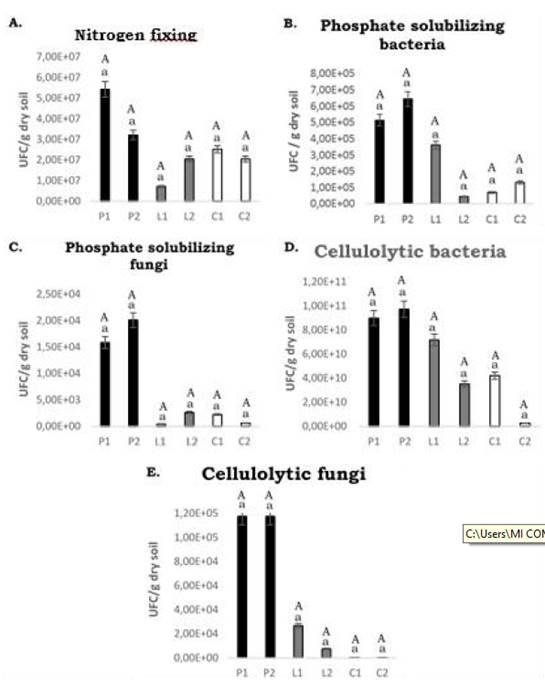
Figure 3 Abundance of functional groups of microorganisms in Páramo, livestock and potato cultivation soils. A. Nitrogen-fixing. B. Phosphate Solubilizing Bacteria. C. Phosphate Solubilizing Fungi. D. Cellulolytic Bacteria. E. Cellulolytic Fungi. P1: Páramo 1, P2: Páramo 2, L1: Livestock 1, L2: Livestock 2, C1: Potato Crop 1, C2: Potato Crop 2. Same lowercase letter does not have a significant statistical difference between uses. Same capital letter does not have a significant statistical difference between altitudes
Figures 3D and 5 present the results for cellulolytic bacteria, and Figures 3E and 5 for fungi, which had no significant differences. Values ranged from 2.79E+ 02 CFU / g ss and 1.18E + 05 CFU / g ss for fungi, and 2.63E + 09 CFU / g ss and 9.74E + 10 CFU / g ss for bacteria; no significant differences were reported in terms of functional groups of microorganisms for altitude variation.
Analysis of enzymatic activities
Urease presented the highest enzymatic activity in soils (Páramo 1:78.9 ug*N/g*dm*2h) (Figures 4A and 5), followed by livestock farming 1 soil (56.06 ug*N/g*dm*2h), and lowest potato cropping 1 soil (44.86 ug*N/g*dm*2h). This trend was only seen in height 1, where the uses of the soil presented significant differences; at height 2, there were no significant differences. Protease behaved opposite to urease, with the highest activity potato cropping 1 soil (1.35 ug*N/g*dm*2h), and Potato cropping 2 (1, 62 ug*N/g*dm*2h); and the lowest on Páramo-1 soil (0.58 ug*N/g*dm*2h), and Páramo-2 (0.76 ug*N/g*dm*2h) (Figures 4B and 5); however, these results did not show significant differences in terms of land use or height.
Acid phosphatase activity was similar to urease, with greater enzymatic activity Páramo 1 soil (6.07 ug*N/g*dm*2h) and lower on potato cropping 1 soil (15, 12 ug*N/g*dm*2h). This was only observed at height 1, while at height 2, there were no significant differences by land uses (Figures 4C and 5). The alkaline phosphatase activity (Fig. 4D, Fig. 5) did not present significant differences in terms of land uses, nor in terms of heights. P-Glucosidase activity was low in Páramo 1 soil (9.01 ug*N/g*dm*2h) and Páramo 2 (5.35 ug*N/g*dm*2h) showed lower enzymatic activity; and Potato cropping 1 soil (18.79 ug*N/g*dm*2h) and Potato cropping 2 soil (27.91 ug*N/g*dm*2h) higher activity of this enzyme. In this case, there were significant differences in terms of land use but not in terms of heights (Figures 4E and 5).
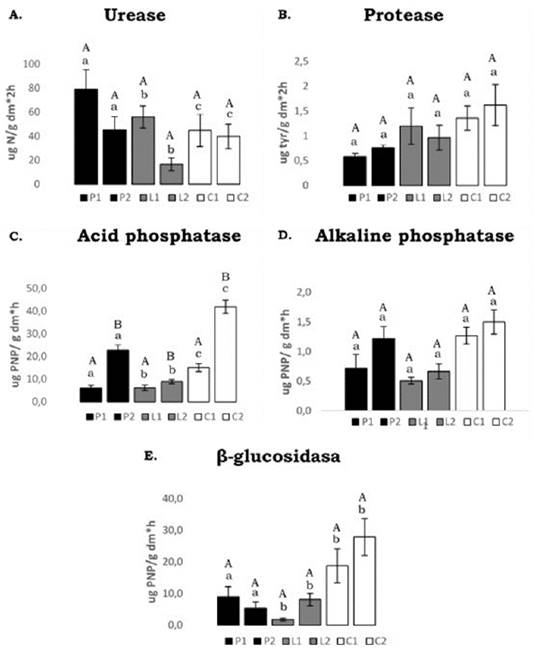
Figure 4 Enzymatic activities in Páramo, livestock and potato cultivation soils. A. Urease. B. Protease. C. Acid Phosphatase. D. Alkaline Phosphatase. E. P-Glucosidase. P1: Páramo 1, P2: Páramo 2, L1: Livestock 1, L2: Livestock 2, C1: Potato Crop 1, C2: Potato Crop 2. Same lowercase letter does not have a significant statistical difference between uses. Same capital letter does not have a significant statistical difference between altitudes.
Discussion
Hypothesis of potato cropping and livestock farming that modify the physicochemical soil properties, abundance of functional groups of microorganisms, and the enzymatic activities in Páramo soils, which are important in a context of conservation of strategic ecosystems in the neotropics ecozone, was evaluated. According to the results, in terms of physicochemical properties, the gravimetric humidity reflected the advantages of Páramo soils that still retain their native vegetation, thus conserving humidity. In the case of livestock farming soils, less moisture was observed even with remnant vegetation cover; livestock farming soil was affected by permanent trampling affecting water retention and water soil content. Cropped soils showed lower humidity, due to the fact that they were more exposed to sun rays and air, increasing evaporation on their surface, and losing the ability to contain moisture (Daza et al, 2014). In terms of apparent density, Páramo soils showed low density, mainly due to high carbon content (Daza et al., 2014); livestock farming soils were already beginning to be compacted, which is associated with the permanent trampling of cattle, while cropped soils exhibited higher apparent density, which was associated with tillage.
Páramo soils revealed significantly higher content of organic carbon with a high correlation with the content of humidity. Livestock farming soils presented less content of organic matter, as they were affected by the trampling actions of the livestock; and potato crops soil showed a very low level of organic carbon due to change of vegetation cover (Martínez, 2008). Organic matter was related to the cation exchange capacity, since it determined the retention and accessibility of nutrients to plants, and it was a way to confirm that given uses to soil affected its quality.
Phosphorus content presented low levels in Páramo soil due to the retention processes of the ecosystem, according to Casasbuenas et al. (2006). Iron and aluminium compounds as well as soil fauna, favour the humification processes; in contrast, there were high levels of phosphorus in crops, possibly caused by the use of phosphate fertilizers.
Due to low temperatures, high relative humidity and precipitation, the decomposition of soil organic matter was carried out at very low rates, exhibiting high content of organic matter, high porosity, and good hydraulic conductivity (Díaz-Granados et al., 2005), hence in these soils without intervention, the tendency in terms of humidity and high organic carbon content, with respect to soils with potato crop and livestock farming intervention, will still be preserved.
Microorganisms abundance had significant differences among soil uses or altitude. Fungi and phosphate-solubilizing bacteria presented greater abundance in Páramo soils compared to potato crop and livestock farming due to the natural processes of phosphate solubilization present that can be inhibited by using fertilizers in potato crops (Moratto et al, 2005). Statistically, there were no significant differences among soil use; following these practices should be taken as an early warning.
Cellulolytic fungi and bacteria were more abundant in Páramo soil compared to other soil uses; a lower abundance in cropped soils was probably due to the application of agricultural inputs, which caused the biological component of the soil to be diminished (Fan et al., 2012), and the loss of organic matter caused by the mechanical removal and turning of soil. However, there were no significant differences for soil use, which is a warning sign for the future if these practices continue.
Urease activity was greater in Páramo soils, and fewer activity was found in livestock farming and in potato cropped soil. This decrease was related to the loss of vegetation cover; so, there was more activity in Páramo due to a greater vegetation cover that protects the microorganisms and the enzymatic activities; while in Potato crop-1, the urease activity was affected by the pesticides that could inhibit the microorganisms that this enzymatic activity produced (Das and Varma, 2011)
Protease activity had no significant differences for different soil uses. These results are consistent with the reported by Avellaneda et al. (2012), who stated that this may be due to the fact that during the growth stationary phase of the bacterial consortiums and a specific morphotype is responsible for one or the other activity (García et al., 2000). Urease and protease activity can be determined during the growth phase, where microorganisms associated with enzyme activity are found, therefore, during the stationary phase, the priority was given to protease or urease activity (Avellaneda et al., 2012).
Acid phosphatase activity presented the highest activity at height 1 and cropped soils, where the use of agrochemicals can modify the soil pH and favour the activity of this enzyme, as indicated by Dick and Tabatabai (1984); Páramo soil presented the lowest activity, even though it is favoured by the available soil nutrient content. At height 2 there was no clear trend showing changes related to potato cropping and livestock farming activities. Alkaline phosphatase activity did not present a significant impact on potato cropping and livestock farming in the soils under study.
P-Glucosidase showed more activity in cropped and livestock farming soil, this would mean that humic substances were degraded by potato cropping and livestock farming, and improve the accessibility for enzymatic activities. Since humic substances are complex and difficult to modify biochemically (Avellaneda-Torres et al., 2013), there was less activity in Páramo soils. In this case, the initial hypothesis of the investigation is partially conlirmed according to the changes presented in enzymatic activities of nitrogen (protease), phosphorus (acid phosphatase), and carbón (P-Glucosidase). The previous results are corroborated by principal component analysis (Figure 5).
Conclusión
Nine physicochemical parameters were analysed; gravimetric humidity, bulk density, organic carbon, capacity of cation exchange, and phosphorus presented significant differences and confirmed the initial hypothesis. From the five enzymatic activities evaluated, three of them (urease, acid phosphatase, and P-Glucosidase) showed significant differences and confirmed the changes produced by the activities of potato cropping and livestock farming. The abundance of microorganisms did not present significant differences related to the agricultural activities; however, the suggestion is to assume them as an early warning of more pronounced damages in the case of continuing with same practices in Páramo soils.













